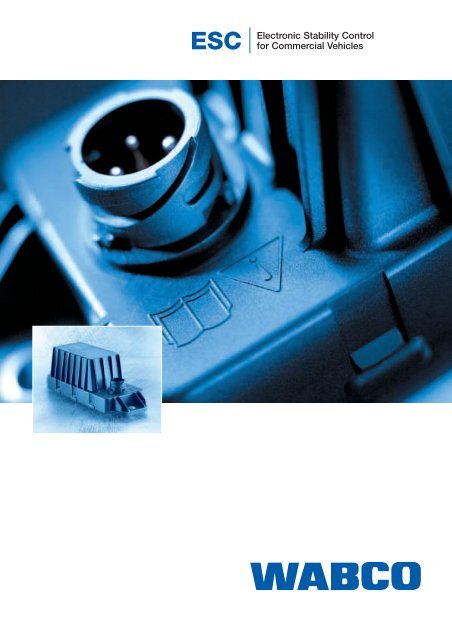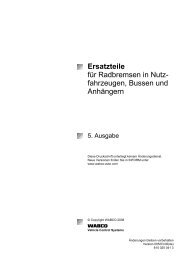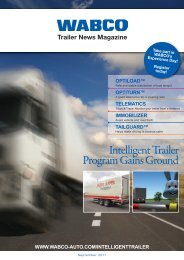ESC Electronic Stability Control for Commercial Vehicles - WABCO
ESC Electronic Stability Control for Commercial Vehicles - WABCO
ESC Electronic Stability Control for Commercial Vehicles - WABCO
You also want an ePaper? Increase the reach of your titles
YUMPU automatically turns print PDFs into web optimized ePapers that Google loves.
<strong>ESC</strong><br />
<strong>Electronic</strong> <strong>Stability</strong> <strong>Control</strong><br />
<strong>for</strong> <strong>Commercial</strong> <strong>Vehicles</strong>
2 <strong>ESC</strong> <strong>Electronic</strong> <strong>Stability</strong> <strong>Control</strong> <strong>for</strong> <strong>Commercial</strong> <strong>Vehicles</strong><br />
<strong>WABCO</strong> sets industry milestones<br />
Highway rush-hour<br />
Drivers of commercial vehicles have been<br />
increasingly supported by active and<br />
passive safety measures. <strong>Vehicles</strong> have<br />
also become much more economical.<br />
<strong>WABCO</strong> has been instrumental in writing<br />
this chapter of technical evolution. The<br />
initial break-through was achieved decades<br />
ago with the introduction of ABS/ASR<br />
(anti-lock and traction control system) as<br />
standard equipment. In 1996, another<br />
Vehicle<br />
safety<br />
milestone followed: <strong>Electronic</strong>ally <strong>Control</strong>led<br />
Braking System (EBS).<br />
With <strong>Electronic</strong> <strong>Stability</strong> <strong>Control</strong> (<strong>ESC</strong>),<br />
<strong>WABCO</strong> extended EBS to allow the<br />
system to automatically intervene in situations<br />
where vehicle stability enters a<br />
critical area, both in normal driving operation<br />
and while a vehicle is being braked.<br />
This is an important contribution to com-<br />
Economy<br />
More safety step by step<br />
EBS – <strong>Electronic</strong> Braking<br />
System <strong>for</strong> trucks and buses<br />
ABS (ASR) <strong>for</strong><br />
trucks and trailer<br />
ACC – Adaptive<br />
Cruise <strong>Control</strong><br />
<strong>ESC</strong> – <strong>Electronic</strong><br />
<strong>Stability</strong> <strong>Control</strong><br />
EBS – <strong>Electronic</strong> Braking<br />
System <strong>for</strong> trailers<br />
mercial vehicle safety in growing traffic<br />
density and given road hazards.<br />
Within physical limits, <strong>ESC</strong> operates automatically<br />
and intervenes in both the drive<br />
train and the brake to support the truck<br />
or bus driver, who might not otherwise be<br />
able to safely steer or brake his vehicle.
<strong>ESC</strong> <strong>for</strong>ged new paths<br />
The first steps along the road to <strong>Electronic</strong><br />
<strong>Stability</strong> <strong>Control</strong> (<strong>ESC</strong>) were taken more<br />
than 10 years ago. Initially, research was<br />
done on a complex vehicle model, and by<br />
computer simulations. The vehicle model<br />
was then extended to a driver model, and<br />
the phase of field driving manoeuvres<br />
began, followed by further development of<br />
the system and pilot-run driving tests on<br />
<strong>WABCO</strong>’s test tracks.<br />
Losing control, semitrailer roll-over without <strong>ESC</strong><br />
The complexity of the testing procedure<br />
can be illustrated by comparing it to similar<br />
systems known from the passenger car<br />
sector. While <strong>ESC</strong> in passenger cars factors<br />
in 1 to 5 people and luggage contained<br />
in a fairly small vehicle with two axles<br />
and only four wheels as well as a fairly<br />
low centre of gravity, the task is <strong>for</strong> more<br />
comlpicated <strong>for</strong> truck <strong>ESC</strong>: On a heavy<br />
duty semitrailer truck an almost infinite<br />
<strong>ESC</strong> 3<br />
range of loads and differences in the<br />
vehicle design, plus high centres of gravity<br />
vary frequently. In addition, the braking<br />
system of a semitrailer must be controlled<br />
via a trailer interface.
4 <strong>ESC</strong> <strong>Electronic</strong> <strong>Stability</strong> <strong>Control</strong> <strong>for</strong> <strong>Commercial</strong> <strong>Vehicles</strong><br />
Fulfilling a complex task<br />
changing lanes<br />
from high to<br />
low coefficient<br />
of friction<br />
Implementing <strong>ESC</strong> requires complex control<br />
engineering, plus high-per<strong>for</strong>mance electronics<br />
and sensors.<br />
The central module of the <strong>Electronic</strong><br />
Braking System (EBS) is connected to the<br />
control units of other systems such as<br />
the engine, the transmission or retarder<br />
via a CAN databus. This allows, <strong>for</strong> instance,<br />
the brake management integrated<br />
in the central module to coordinate air<br />
brakes with endurance brakes.<br />
without <strong>ESC</strong> with <strong>ESC</strong><br />
negotiating a<br />
bend low coefficient<br />
of friction<br />
The EBS of a semitrailer also exchanges<br />
its data with the vehicle via the CAN databus<br />
to optimise the braking behavior <strong>for</strong><br />
the whole tractor-trailer combination.<br />
Semitrailers with conventional braking<br />
systems are controlled from the towing<br />
vehicle via electro-pneumatic trailer<br />
controls.<br />
The <strong>ESC</strong> central module communicates<br />
with the EBS central module via the highper<strong>for</strong>mance<br />
databus of the braking<br />
system. The <strong>ESC</strong> central module works<br />
with high-per<strong>for</strong>mance microprocessors, a<br />
yaw rate sensor and an acceleration sensor.<br />
For this purpose, all inputs from the<br />
vehicle’s sensors are transmitted to a<br />
computer module. This computer module<br />
then compares the actual condition of the<br />
without <strong>ESC</strong> with <strong>ESC</strong><br />
vehicle with those permissible in theory.<br />
<strong>ESC</strong> intervenes if an approximation of the<br />
two values is detected, or if the reading<br />
exceeds the maximum reference value.<br />
The sensors <strong>for</strong> the <strong>ESC</strong> system<br />
consist of:<br />
■ ABS sensors <strong>for</strong> measuring<br />
wheel speed<br />
■ Steering angle sensor to reflect the<br />
driver’s motions<br />
■ Lateral acceleration sensor which<br />
measures the actual vehicle behavior<br />
and indicates the cornering situation<br />
■ Yaw rate sensor
Easy installation<br />
The <strong>ESC</strong> control module has been designed<br />
to be easily installed, yet withstand<br />
the harsh operating conditions of the<br />
vehicle frame: vibration, dirt, water, salt,<br />
ice and snow, changing temperatures and<br />
electro-magnetic stress.<br />
10<br />
2<br />
ENGINE<br />
TRANS-<br />
MISSION<br />
EBS system layout 1P/1E with <strong>ESC</strong><br />
1<br />
PERMANENT<br />
BRAKE<br />
VEHICLE DATABUS J 1939<br />
3<br />
4<br />
4<br />
The steering angle sensor can be integrated<br />
either in the steering wheel or in the<br />
steering gear. At 0.2°, its resolution has<br />
been designed to anticipate even future<br />
requirements. <strong>Control</strong> systems such as a<br />
“doze warner” which would require such<br />
accuracy can thus simply be docked onto<br />
the CAN databus, and no investment in<br />
an additional sensor will be necessary.<br />
8<br />
7<br />
9<br />
7<br />
8<br />
ISO 11992<br />
LEVELING<br />
CONTROL<br />
AIR RESERVOIR<br />
ASV<br />
6<br />
ISO 7638<br />
5<br />
<strong>ESC</strong> 5<br />
8<br />
7<br />
7<br />
8<br />
<strong>ESC</strong> Module<br />
1 EBS Central Module (ECU)<br />
2 Brake signal transmitter<br />
3 Proportional relay valve<br />
4 ABS solenoid valve<br />
5 Axle modulator<br />
6 Trailer control valve<br />
7 Speed sensors<br />
8 Wear sensors<br />
9 <strong>ESC</strong> module<br />
10 Steering angle sensor
6 <strong>ESC</strong> <strong>Electronic</strong> <strong>Stability</strong> <strong>Control</strong> <strong>for</strong> <strong>Commercial</strong> <strong>Vehicles</strong><br />
Increased road safety<br />
Driver’s reaction<br />
The system components of <strong>WABCO</strong>’s<br />
<strong>ESC</strong> automatically and actively reduce the<br />
hazards of swerving when negotiating<br />
curves and when taking evasive action.<br />
This applies even when the vehicle is<br />
moving on changing road surfaces, and<br />
when road features are combined with<br />
steering mistakes. In such situations,<br />
where driving dynamics are critical, <strong>ESC</strong><br />
uses EBS to control the braking <strong>for</strong>ces on<br />
each wheel, at the same time throttling the<br />
vehicle’s engine output.<br />
<strong>ESC</strong> prevents semitrailer jack-knifing by<br />
simultaneous measured braking of the<br />
semitrailer, even if it is equipped with a<br />
conventional braking system.<br />
The third issue addressed by <strong>ESC</strong> is the<br />
semitrailer’s tendency to tilt. This increases<br />
at higher speeds in long curves<br />
(e.g. motorway exits) and can also be<br />
caused by changing lanes rapidly. When<br />
this happens, <strong>ESC</strong> automatically reduces<br />
the speed of the tractor-trailer combi-<br />
nation when the tilting limit is reached.<br />
This occurs independently of the driver’s<br />
behavior in response to the vehicle’s imminent<br />
instability.
Safety <strong>for</strong> people and vehicles<br />
Evasive action with <strong>ESC</strong><br />
Today <strong>WABCO</strong>’s <strong>ESC</strong> is becoming stateof-the-art,<br />
as EBS did years ago, or ABS/<br />
ASR in the early 1980s. <strong>WABCO</strong> continues<br />
to innovate systems which – linked to<br />
dynamic navigation, driving dynamics and<br />
cruise control systems – will further revolutionize<br />
long-distance road transportation.<br />
<strong>ESC</strong> 7
<strong>WABCO</strong>, the vehicle control systems business<br />
of American Standard Companies, is<br />
the world’s leading producer of electronic<br />
braking, stability, suspension and transmission<br />
control systems <strong>for</strong> heavy duty commercial<br />
vehicles. <strong>WABCO</strong> products are<br />
also increasingly used in luxury cars and<br />
sport utility vehicles (SUVs). Customers<br />
include the world’s leading commercial<br />
truck, trailer, bus and passenger car manufacturers.<br />
Founded in the US 135 years<br />
<strong>WABCO</strong> WORLDWIDE<br />
ago as Westinghouse Air Brake Company,<br />
<strong>WABCO</strong> was acquired by American<br />
Standard in 1968. Headquartered in<br />
Brussels, Belgium, the business today<br />
employs nearly 6500 people in 29 office<br />
and production facilities worldwide. In<br />
2003, <strong>WABCO</strong> contributed US$ 1.358<br />
billion to American Standard’s total sales<br />
of US$ 8.568 billion.<br />
Website: www.wabco-auto.com<br />
Vehicle <strong>Control</strong> Systems<br />
An American Standard Company<br />
© 2004 American Standard Companies Inc. All rights reserved. 820 001 306 3/08.2004
















